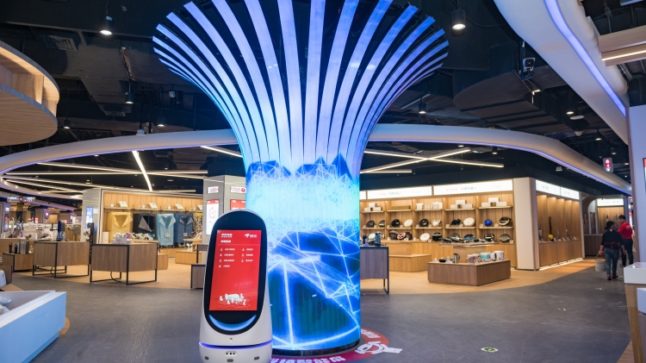In Part 1, I laid out why I think JD’s e-space was a pretty bold move – and opens a new frontier in OMO retail.
My argument was that as you move from retail about buying products in the supermarket to visiting shopping malls and department malls, you start to really merge products, services and experiences. And you raise the question of what a truly digital-first lifestyle looks will look like.
For JD’s e-space, I have six questions:
Question 1: In which product categories can the consumer experience dramatically improve?
JD’s initial offering to consumers appears to be “fun”, “service” and “convenience” (from their press release). It is “experiential” shopping.
And that’s not bad. But you really have to look at it product category by category. Where can experiences really improve with digital? I really don’t need a lot of experiential shopping when buying a toaster.
The experience areas JD mentions include gaming, wine, coffee, and beauty (treatments, hair, nails, etc.). And those do seem pretty great. And I assume they have brands L’Oréal, Nestle, Huawei and Apple running some of the larger spaces. So I suspect these are pretty awesome. But I really want to see which ones move the needle. I’m also hoping Huawei does some of their lighted drone shows in their space (It shows off 5G capabilities. You can see an example here).
Question 2: How much integration is there with the mobile apps and on-demand delivery?
In Intime’s flagship store, they improved the mobile app and added on-demand delivery. That effectively increased the radius of the store from its walls to 2-3 km around the store. That’s really powerful and lets you dramatically increase the sales per square meter (which lets you spend more on the space and make it nicer).
I’m curious how this will work when your store is focused primarily on experiences (which Intime is not yet). How much is JD integrating mobile apps (theirs and merchants) with the store? And on-demand delivery? Note: delivery in Chongqing is kind of complicated given the crazy geography. There’s a good article about that called “Food Delivery Apps are No Match for Chongqing’s Graceful Disorder“.
I always think about what I can do sitting on my sofa down the street. What can I order and have delivered immediately? How much impulse purchasing is going on? For smartphones? Snacks? Beauty products? Clothing? Shoes? This is fairly powerful in grocery stores. The Hema / Freshippo stores apparently have 60-70% of sales coming from people outside of the store.
And, mostly importantly, integrating the mobile app creates two-way connectivity with local customers 24/7. That is a dramatic improvement from waiting for people to come into the store.
Question 3: What can the e-space do in personalization? And with the integration of inventory and data?
One cool thing about new retail is the ability to combine the inventory in the stores with the inventory online. The store can become the sales, delivery and pick-up point for the entire inventory offline and online. And you can also combine the data for both the customers and inventory. That is really important.
Because once you combine the inventory and customer data, you can start to personalize the products, services and experiences within the store to customers – just like happens online. Amazon for you looks different than Amazon for me. But the physical stores are still the same. Integrated customers, data and inventory let you personalize via the mobile app and the digital screens. Suddenly your experience in the Huawei experience center is different than mine.
Overall, products, services and experiences in the real world should become increasingly dynamic, data-driven and personalized. Just like online. I’m looking for how much of this is happening in the e-space.
Question 4: Combining products, services and experiences should be amazing.
Ok. That’s not a question.
I really like the idea of personalization in the physical world. And it gets more interesting when you start to combine products with services and experiences. Suddenly you can offer an individualized assortment of outfits and make-up to a customer (product personalization), to be delivered or picked-up in the store. And you can combine it with a make-up artist and hair stylist (service personalization), who can be in the store or at the person’s home. And you can bundle these, which is a particularly powerful tool in the digital world.
For example,
- You can bundle beauty products with beauty treatments and services.
- You can bundle apparel with personalized design and fitting services.
- You can bundle food products with food preparation.
- You can bundle birthday gifts with movie tickets and other experiences.
Imagine all products, services and experiences personalized and packaged for you as you go to the shopping mall or around town? Based on a deep knowledge about what you like. That’s when the idea of a digital lifestyle becomes really intriguing. A personalized world of products, services and experiences just for you.
Question 5: Will e-space become a dynamic shopping mall with constantly changing stores and experiences?
How did JD determine which 55 brand experiences to offer in the e-space? And how frequently is the mix of brands changing? Every year? How about every week?
I’m going to guess that the current mix was chosen via a pretty data-driven selection process based on what people spend in the local area. By looking at both current and potential customers. And I’m assuming JD then invited certain brands. The brands then built their experience spaces and did their thing. And there is a lot of tracking of sales and engagement. At some point, they will start to make changes to the mix of brands and experiences. To improve the e-space. But also just to keep the experiences changing.
So how frequently are they going to do this? Is the mall itself going to be dynamic and evolving in terms of the products, stores and experiences?
I think this makes the idea of going to the mall every weekend much more interesting.
- What if every 2 months, 30-40% of the stores in the mall are new? The big brands will likely stay the same but there could be spaces that change frequently. Lots of new little food stalls. Lots of new niche brands being introduced.
- What if every 2 months, 50% of all the inventory in all the stores is new?
- What if the experiences and services are also changing just as fast?
Note: we see this pattern in digital goods. New movies are released every week and people all go to the mall to watch them. People change what music they listen to over time. Fads come and go. If shopping malls are about experiences and not just products, shouldn’t they be similar?
Some questions:
- Would a dynamic mall with frequent new releases increase the frequency of people coming to visit?
- Would this increase engagement?
- Would this increase overall consumption?
- Would a dynamic mall change the process of discovery and education about brands and new products?
Final Question: What does a digital-first lifestyle look like?
This is my big question. And I think Chinese consumers are going to be the ones to figure it out first. In China, we have a +1B person critical-mass of digital-first consumers. There are rapid adopters of digital tools. There are lots of them. And they are concentrated in dense urban areas.
This is why I am pretty excited about shopping malls, department stores and walking streets for OMO retail. Because these spaces tend to capture most aspects of our lives. Shopping, entertainment, family, community, etc. We’ll see.
That’s it. Cheers,
Jeff
——
I am a consultant and keynote speaker on how to accelerate growth with improving customer experiences (CX) and digital moats.
I am a partner at TechMoat Consulting, a consulting firm specialized in how to increase growth with improved customer experiences (CX), personalization and other types of customer value. Get in touch here.
I am also author of the Moats and Marathons book series, a framework for building and measuring competitive advantages in digital businesses.
Note: This content (articles, podcasts, website info) is not investment advice. The information and opinions from me and any guests may be incorrect. The numbers and information may be wrong. The views expressed may no longer be relevant or accurate. Investing is risky. Do your own research.

